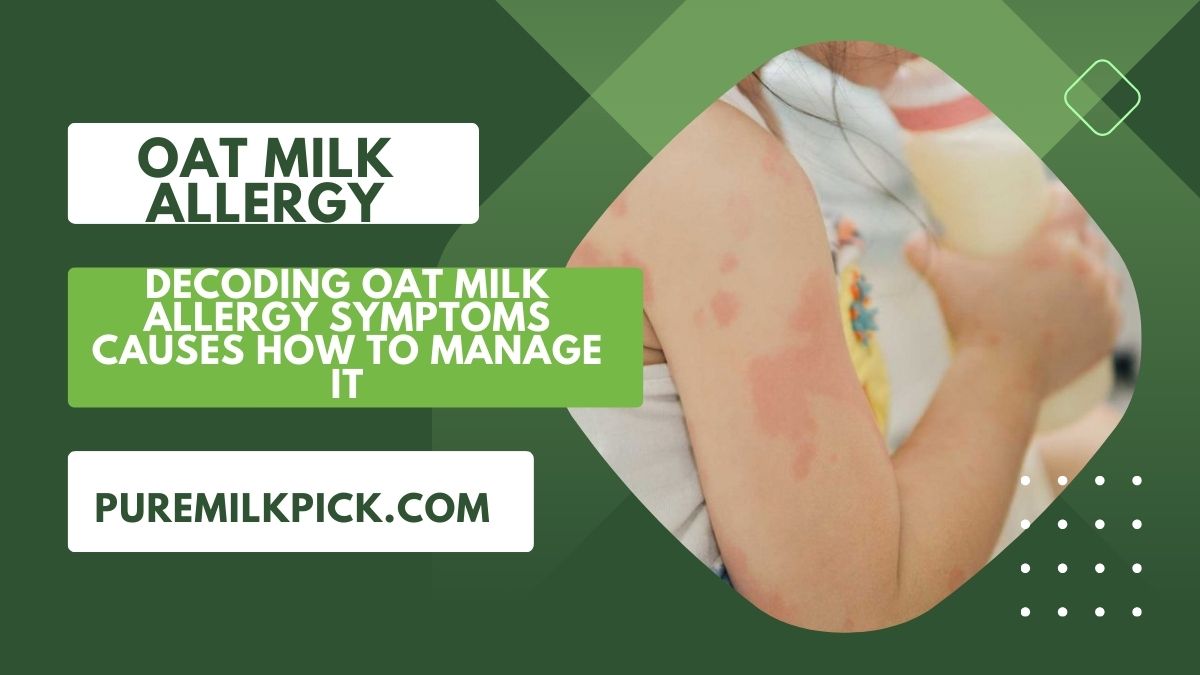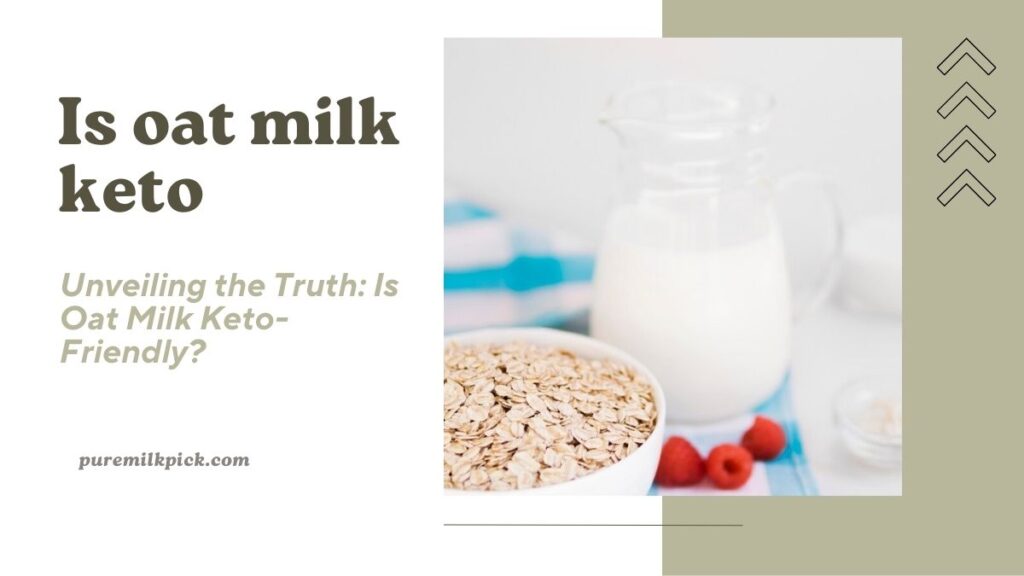Welcome to the realm of dairy alternatives, where oat milk has taken the culinary world by storm. As more individuals seek plant-based milk options for health reasons or dietary preferences, the surge in oat milk consumption has brought forth concerns about allergies associated with this trendy beverage. In this comprehensive guide, we’ll delve into the depths of oat milk allergy, exploring its symptoms, causes, and effective management strategies.
What is Oat Milk?
The Rise of Oat Milk
Oat milk, crafted from oats and water, has gained immense popularity in recent years owing to its creamy texture, nutritional benefits, and suitability for various diets such as vegan and lactose intolerance. This dairy alternative’s surge in demand is attributed to its sustainable production and perceived health advantages, contributing to its widespread usage in coffee shops, homes, and restaurants globally.
Nutritional Profile and Health Benefits
Rich in nutrients like fiber, vitamins, and minerals, oat milk offers a commendable nutritional profile. Its cholesterol-lowering properties, potential heart health benefits, and versatility in cooking and baking have contributed to its reputation as a healthy milk substitute.
Culinary Usage and Adaptability
Oat milk’s adaptability in cooking and its ability to froth well for coffee-based beverages have made it a favorite among baristas and home cooks alike. Its neutral taste and ability to complement various flavors have further cemented its place in the culinary world.
Learn more about the nutritional benefits of oat milk here.
Oat Milk Allergy: Understanding the Basics
Defining Food Allergies
Food allergies represent the immune system’s adverse reactions to specific proteins in certain foods. Oat milk allergy, a subtype of food allergy, emerges when the immune system mistakenly identifies proteins within oat milk as harmful, triggering an allergic response.
Specifics of Oat Milk Allergy
Oat milk allergy involves the body’s immune system responding abnormally to proteins present in oat milk. While less common than allergies to nuts or dairy, the prevalence of oat milk allergies has been rising, necessitating a deeper understanding of its mechanisms and effects.
Comparing Oat Milk Allergy to Other Food Allergies
In comparison to prevalent food allergies like peanuts, dairy, or gluten, oat milk allergies are relatively less frequent. However, for individuals susceptible to oat milk protein, the allergic reactions can range from mild discomfort to severe and life-threatening.

Causes and Triggers of Oat Milk Allergies
Protein Components Responsible for Allergic Reactions
The proteins avenin and gliadin found in oats are primarily responsible for triggering allergic responses in individuals prone to oat milk allergies. These proteins can incite the immune system to produce antibodies, leading to an allergic reaction upon oat milk consumption.
Cross-Reactivity and Related Allergies
Cross-reactivity between oat proteins and those found in other grains like wheat or barley might exacerbate oat milk allergies, especially in individuals with pre-existing sensitivities or allergies to these grains. Understanding these potential cross-reactivities is crucial in managing oat milk allergy effectively.
Contributing Factors to Oat Milk Allergy Development
Several factors, including genetics, environmental elements, and an individual’s immune system response, contribute to the development of oat milk allergies. Additionally, early exposure to oats or a family history of food allergies might heighten the likelihood of developing an allergic reaction to oat milk.
Symptoms of Oat Milk Allergies
Immediate Allergic Reactions
Upon ingestion of oat milk or oat-containing products, immediate allergic reactions may manifest as hives, itching, swelling, or respiratory issues like wheezing or difficulty breathing. In severe cases, anaphylaxis, a life-threatening allergic reaction, may occur, necessitating immediate medical attention.
Delayed Reactions and Manifestation
Some individuals might experience delayed allergic reactions several hours after consuming oat milk, presenting symptoms such as digestive disturbances, eczema, or other skin irritations. These delayed responses can complicate diagnosing oat milk allergies, requiring careful observation and medical assessment.
Varying Severity and Impact
The severity of oat milk allergy symptoms can vary significantly among individuals. While some may experience mild discomfort, others might face severe reactions affecting multiple organ systems, potentially impacting their daily activities and quality of life.
Read More: Incorporating Oat Milk into a Keto Diet: A Comprehensive Guide
Diagnosis and Testing for Oat Milk Allergies
Medical Procedures and Diagnostic Tests
Consulting a healthcare professional is crucial for an accurate diagnosis of oat milk allergy. Skin prick tests, blood tests measuring specific antibodies, and oral food challenges are among the diagnostic procedures employed to confirm oat milk allergies and differentiate them from other conditions.
Importance of Professional Diagnosis
Self-diagnosis or relying solely on symptoms without professional confirmation may lead to misinterpretation and improper management of allergic reactions. Seeking medical advice ensures accurate diagnosis and personalized guidance on managing oat milk allergies effectively.
Distinguishing Allergy from Intolerance
It’s essential to differentiate between an allergy and intolerance to oats or oat milk. While allergies involve the immune system, intolerances typically stem from digestive issues and don’t trigger an immune response. Professional diagnosis helps distinguish between the two for appropriate management.

Management and Treatment
Primary Strategy: Avoidance
The cornerstone of managing oat milk allergies is strict avoidance of oat milk and products containing oats. Thorough label reading, heightened awareness of hidden sources of oats, and vigilance while dining out are imperative to prevent accidental exposure to allergens.
Identifying Hidden Sources and Label Reading
Oats can be present in various food items and products beyond obvious sources like oatmeal or cereal. Understanding label terminology and being aware of ingredients such as oat flour, beta-glucan, or avena sativa assists in identifying hidden oat components in packaged foods.
Alternative Milk Options
For individuals allergic to oat milk, exploring alternative milk options such as almond, soy, rice, or coconut milk can provide suitable substitutes in recipes, beverages, and everyday consumption, catering to varying taste preferences and nutritional requirements.
Living with Oat Milk Allergy
Coping Strategies and Support
Adjusting to life with an oat milk allergy involves implementing coping strategies, seeking support from allergists or support groups, and educating oneself and others about the condition. Developing a personalized action plan and carrying emergency medications like epinephrine injectors is vital for safety.
Navigating Social Situations
Social gatherings and dining out may present challenges for individuals with oat milk allergies. Effective communication with hosts or restaurant staff, carrying safe snacks, and advocating for one’s needs play pivotal roles in navigating such situations without compromising health.
Education and Awareness
Educating family, friends, colleagues, and caregivers about oat milk allergies fosters understanding and support. Clear communication regarding allergen safety measures and creating a safe environment helps prevent accidental exposure to oat milk.

Oat Milk Allergy in Children vs. Adults
Prevalence and Manifestation in Different Age Groups
Oat milk allergies can affect individuals across various age groups, but prevalence and manifestation might differ. Children might outgrow certain allergies, while adults might develop new sensitivities, requiring tailored approaches to managing oat milk allergies.
Unique Challenges for Children
Children with oat milk allergies face specific challenges, including limited food choices, potential peer pressure, and difficulties in communicating their needs. Parental vigilance, education, and collaboration with healthcare providers are crucial in managing oat milk allergies in children effectively and ensuring their safety in various environments.
Management Approaches for Different Age Groups
While the fundamental management principles remain consistent, adjusting strategies and communication approaches according to age-specific needs is essential. Providing age-appropriate education, involving children in their care, and fostering independence help manage oat milk allergies effectively.
Research, Future Outlook, and Conclusion
Ongoing Research and Development
Continued research endeavors focus on understanding oat milk allergies better and exploring potential treatments or preventive measures. Advancements in allergen-free food production and innovations in immunotherapy hold promise for individuals with oat milk allergies.
Promising Trends in Allergen-Free Food Production
The food industry’s efforts to accommodate individuals with various allergies, including oat milk, are evident in the increasing availability of allergen-free options. Innovation in manufacturing processes and product labeling aims to enhance safety and accessibility for consumers with dietary restrictions.
Encouragement and Staying Informed
For individuals navigating life with oat milk allergies, staying informed about new developments, seeking professional guidance, and remaining vigilant while managing dietary choices are pivotal. Despite the challenges, advancements in research offer hope for improved management and quality of life for those affected.
Conclusion
In conclusion, while oat milk serves as a popular dairy alternative, its rising consumption has paralleled increased concerns about oat milk allergies. Understanding the symptoms, causes, and effective management strategies is imperative for individuals susceptible to oat milk allergies. Rigorous avoidance, informed label reading, seeking a professional diagnosis, and fostering a supportive environment is crucial in managing oat milk allergies and ensuring safety.
FAQs about Oat Milk Allergy
Like other food allergies, oat milk allergies can develop at any age. Some individuals might experience sudden onset symptoms upon initial exposure, while others may develop allergies gradually.
Currently, the primary treatment for oat milk allergies involves strict avoidance of oat milk and related products. However, ongoing research explores potential treatments like immunotherapy, aiming to desensitize the immune system’s response to oat proteins.
While some children may outgrow oat milk allergies, especially those with mild reactions, it’s essential to consult healthcare professionals for accurate diagnosis and guidance. Adult-onset allergies might persist, requiring ongoing management.



